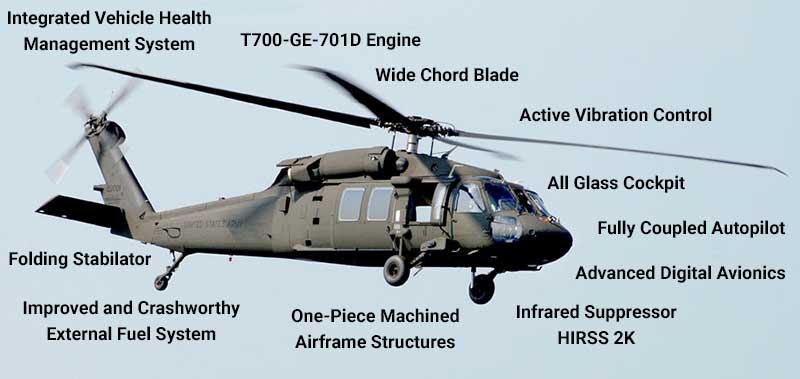UH 60 Helicopter Maintenance: A Comprehensive Guide for Pilots
UH 60 Helicopter Maintenance: A Comprehensive Guide for Pilots
Blog Article
Comprehending the Mechanics and Design Behind Uh 60 Helicopters
The UH-60 helicopter, commonly referred to as the Black Hawk, stands as a peak of modern-day rotorcraft technology, personifying a blend of robust engineering and complex auto mechanics. From its creation to its current versions, the evolution of this aircraft showcases a combination of technology and practicality. As we peel off back the layers of the UH-60's layout, a globe of complex systems and thorough design comes to light. Comprehending the auto mechanics and design behind this flexible airplane unveils a world where accuracy fulfills power, and where each element plays a critical function in achieving flight.
Background of UH-60 Helicopters
The background of UH-60 helicopters traces back to the late 1970s when the USA Military looked for a innovative and flexible utility helicopter to change its aging fleet. In feedback to this requirement, the Sikorsky Airplane Firm developed the UH-60 Black Hawk helicopter. Introduced in 1979, the UH-60 swiftly ended up being a staple in army procedures due to its impressive capacities.
The UH-60 was developed to excel in a selection of missions, including army transport, medical discharge, digital war, and special operations. Its ability to adapt to various duties made it a useful property to the united state Army and other army forces around the globe
For many years, the UH-60 platform has actually undertaken a number of upgrades and variants to improve its performance and maintain speed with progressing goal needs. These helicopters have seen extensive solution in problems such as the Gulf War, Afghanistan, and Iraq, showcasing their integrity and adaptability in varied functional atmospheres. The UH-60's abundant history is a testament to its enduring heritage as a top energy helicopter.

Engine and Power Equipments
Utilizing sophisticated propulsion technology, UH-60 helicopters are geared up with innovative engine and power systems to ensure optimum efficiency and dependability in a variety of functional situations. The UH-60, typically understood as the Black Hawk, is powered by 2 General Electric T700-GE-701D engines, each with the ability of delivering up to 1,940 shaft horse power. These turboshaft engines offer the required drive for the helicopter to perform its objectives effectively, including troop transport, medical discharge, and combat assistance.

Blades System and Aerodynamics
Just how do the blades system and aerodynamics of UH-60 helicopters contribute to their functional efficiency and flight visit site capacities? The blades system of the UH-60 helicopter plays an important role in giving lift and propulsion.
Aerodynamics likewise play an essential duty in the performance of UH-60 helicopters. The structured body and rotor blade layout minimize drag, permitting the helicopter to accomplish higher speeds and better fuel efficiency. The wind resistant style of the UH-60 additionally adds to its capacity to run in varied environmental problems, consisting of warm temperature levels and high altitudes.
Avionics and Flight Control Solution

In its elaborate coordination with the rotor system and aerodynamics of UH-60 helicopters, the avionics and trip control systems create an essential network of technologies shaping the airplane's functional capacities. Avionics incorporate the digital systems utilized for interaction, navigating, and monitoring different airplane functions. In the UH-60, these systems consist of electronic displays, communication radios, general practitioner navigating, weather condition radar, and autopilot systems. These avionics systems provide important information to the pilots, enhancing situational awareness and making sure secure and efficient procedure of the helicopter.
The flight control systems of the UH-60 are in charge of translating the pilot's inputs into the proper changes to the blades system, ensuring steady flight and ability to move. These systems are composed of hydraulic actuators, servos, and computers that collaborate to regulate the major and tail blades, in addition to various other trip best site control surface areas. By precisely taking care of the helicopter's flight dynamics, these systems make it possible for pilots to carry out a variety of missions, from transportation and search-and-rescue to deal with operations, with accuracy and confidence.
Role and Applications in Aeronautics
Avionics systems in UH-60 helicopters include an array of digital systems that aid in navigating, communication, tracking, and regulating numerous aircraft functions. These systems consist of digital display screens, autopilot systems, communication radios, General practitioner navigation tools, and climate radar. Furthermore, these systems integrate security attributes such as autopilot modes, surface recognition warning systems, and security enhancement systems to boost the total safety and security click for info and operational capabilities of the UH-60 helicopters in different objectives, including troop transport, medical evacuation, search and rescue, and airborne firefighting.
Conclusion
In conclusion, the UH-60 helicopter is a functional airplane with an abundant background and progressed engineering. Its engine and power systems, rotor system, aerodynamics, avionics, and trip control systems all function together to make it a effective and dependable equipment.
In its detailed coordination with the rotor system and the rules of aerodynamics of UH-60 helicopters, the avionics and trip control systems create an essential network of innovations shaping the airplane's functional capabilities.The flight control systems of the UH-60 are accountable for equating the pilot's inputs into the appropriate adjustments to the rotor system, ensuring stable trip and maneuverability. Avionics systems in UH-60 helicopters incorporate an array of electronic systems that aid in navigating, interaction, surveillance, and regulating numerous aircraft features. Furthermore, these systems incorporate safety attributes such as auto-pilot settings, terrain understanding alerting systems, and stability augmentation systems to enhance the general safety and functional capacities of the UH-60 helicopters in various objectives, consisting of army transport, medical evacuation, search and rescue, and airborne firefighting.
Its engine and power systems, blades system, the rules of aerodynamics, avionics, and flight control systems all function with each other to make it a reputable and reliable device.
Report this page